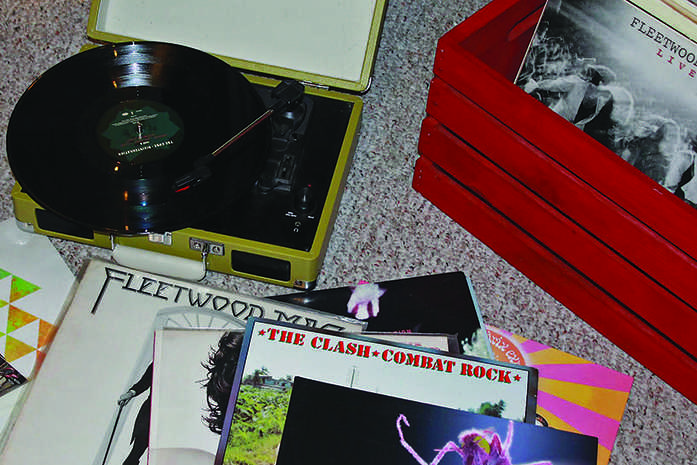By Cindy Garcia | cindy-garcia@uiowa.edu
There’s nothing like sliding a vinyl record out of its sleeve, setting it down, and dropping a needle on it.
At least that’s what University of Iowa junior Amanda Bartlett thinks, and an increasing number of people agree with her.
“It’s just so much more of an experience and deliberate action rather than just listening to music on my phone,” Bartlett said.
In a 2015 Nielsen midyear report, vinyl LP sales were up 38 percent and made up nearly 9 percent of total physical album sales. Last year, vinyl unit sales totaled 9.2 million, up from 6.1 million in 2013.
Bartlett, who has collected vinyl for three years, estimates her collection holds 30 or 40 records.
“I enjoy collecting vinyl because I think I notice with myself and other people who like to buy them there’s just that pride and sense of ownership,” she said. “You’re not just getting the music. Different records have different pressings. They can come in cool colors. It’s just like a piece of art.”
UI junior Mohammad Cheetany agrees. He has collected vinyl for seven years. The favorites in his collection, an estimated 100 records, include colored vinyls, white vinyls, and 7-inch singles.
“I think the physicality of it is really important when it comes down to music, because that aspect had been gone for the past 10 years because of the shift to digital music,” he said. “I like that you can hold it in your hand. It becomes a piece of your collection.”
Bartlett and Cheetany both belong in the demographic largely responsible for the increasing sales. According to Media Watch, half of vinyl consumers are under the age of 25.
To Bobby Larson, a 10-year on-and-off employee at Record Collector, 116 S. Linn St., the change in consumers is noticeable.
“There’s a little bit of mix, but we’re definitely getting more younger customers, more college age kids, and even high-school students a little bit. It’s good to see,” he said. “There’s definitely been a younger crowd that has gained an interest in records that wasn’t there 10 or 15 years ago.”
Larson, however, remains skeptical about continuing growth in sales because of supply and demand imbalances. Larson said prices have gone up on records from major labels.
“I think they’re kind of trying to take advantage of the situation, seeing it as a fad and trying to get as much money out of it in the immediate timeframe rather than looking at it as something that could last,” he said. “They could be investing in more record plants and pressing more records and approaching it from a long-term standpoint, but I don’t know that they are.”
For Chicago-based Gramaphone Records, there isn’t a problem with supply because of the store’s focus on electronic music.
“There’s a delay for up to six months for people who want to press records, but we have no problems stocking them,” said storeowner Michael Serafini.
Serafini noted that overall increases in vinyl sales have helped his store, which opened its doors in 1969.
“The resurgence of people buying vinyl rock and jazz records has been drifting over to the electronic realm, and there are now more people buying electronic vinyls,” he said.
Most remain unsure if the boom is built to last, but some agree that a niche market will continue to exist.
“What I like about my record collection is that I view it as something that someday I can pass along to my kids,” Bartlett said. “I can sit down with them and show them, ‘Here’s a couple of my favorite albums.’ ”
She said her father has taken her through his collection.
“When he found out I was into them, he got all excited, and he showed me all the bands he listens to,” she said. “It’ll always be around because it creates a sense of connection between people that other formats of music don’t.”



